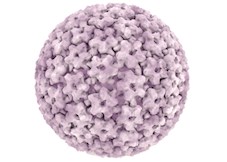A healthier future for Australian patients
The way Australian patients are screened for cervical cancer has changed. The Medical Services Advisory Committee (MSAC) recommend a liquid based collection for HPV DNA testing with a 5-yearly screening interval. Screening now commences at 25 years of age.
Download Cervical Screening Program BrochureInformation on HPV Self-Collect Testing
Cervical Testing with a Molecular HPV Test
A sample of cells is collected from the cervix into the liquid-based specimen vial, which is analysed to identify the presence of HPV viral DNA at the molecular level. The traditional glass slide Pap smear has been phased out and now incurs a private fee as the Medicare Benefits Schedule (MBS) no longer covers the cost and is not recognised by the new guidelines.
What do I need to know?
Patients aged 25 to 74 years are invited every 5 years to have an HPV test. This includes both vaccinated and unvaccinated screening participants.
- If HPV is not detected, cytology will not be performed and a recommendation to repeat screening in five years will be made. Cytology will be performed if the patient has presented with symptoms of cervical disease or is undergoing management of a cervical abnormality.
- If HPV is detected, a reflex Liquid Based Cytology (LBC) (ThinPrep) will be performed on the same specimen.
There will be a combined report for HPV and cytology (LBC) results, which includes a risk category and the recommended management, in line with the guidelines.
There are three risk categories:
- Patients who are classified as Low risk are routinely invited to re-screen in five years.
- Patients who are classified as Intermediate risk are routinely invited to have another HPV test in 12 months. This is to check that the infection has cleared.
- Patients classified at Higher risk are routinely referred directly to colposcopy for further investigation.
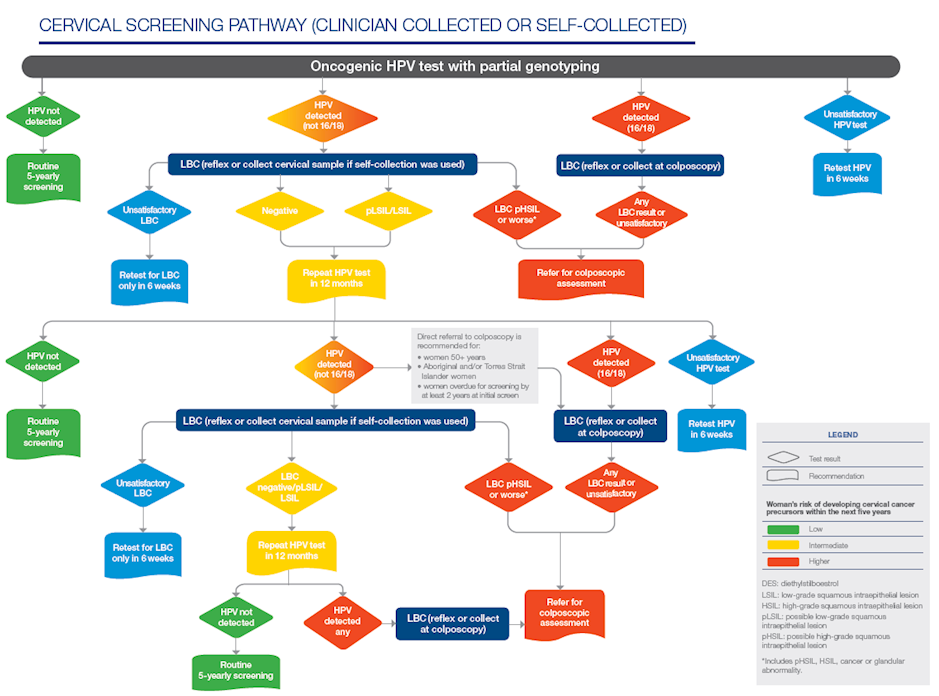
Symptomatic patients
It is important to remember that symptomatic patients may have a cervical sample taken at any time, regardless of their age or screening history. Patients at any age who have signs or symptoms suggestive of cervical cancer, or its precursors, will have a co-test (LBC and HPV).
The presence of symptoms should be clearly noted on the request form to ensure cytological examination is performed on these specimens.
Age for first HPV screening
The guidelines advise that both HPV vaccinated and unvaccinated patients from the ages of 25 to 74 should participate.
This age range is based on evidence that cervical cancer in young patients is rare and screening patients younger than 25 years of age has not altered the number of cervical cancer cases or deaths in this group. This measure also prevents the over-treatment of common cervical abnormalities in young patients, which usually resolve naturally.
In addition, HPV vaccination has already and will continue to show a significant reduction of these abnormalities amongst patients in this age bracket. If a screening participant under the age of 25 is symptomatic, an HPV test can be requested that will be covered as a MBS item.
How to order a Cervical Screening Test
| Patient presents as |
Context | Age | Sample type | Test type | What to write on the pathology request form |
|
Asymptomatic |
National Cervical Screening Program routine five-yearly screening
|
≥ 24yrs |
Cervical | HPV test | Cervical Screening Test (CST) |
| Asymptomatic
|
Screening in specific populations
|
Any age | Cervical | HPV test |
|
|
Follow-up test claimable after previous positive screening test (12-month repeat) |
Any age |
Cervical |
HPV test |
Follow-up HPV test | |
|
Follow-up or post-treatment for clinical management
|
Any age |
Cervical |
Co-test (HPV & LBC) |
|
|
|
Symptomatic |
For investigation of symptoms, e.g. abnormal bleeding |
Any age |
Cervical |
Co-test (HPV & LBC) |
Co-test or HPV & LBC, Symptomatic (specify) |
| Follow-up for HPV+ self-collect | Only claimable within 21 months following the detection of oncogenic HPV (any type) on a self-collected screening test | > 24yrs & 9mths |
Vaginal | LBC | HPV+ self-collect follow-up test |
| Cervical | LBC | HPV+ self-collect follow-up test | |||
| Repeat test following an unsatisfactory test |
Following an unsatisfactory test
|
Any age | Cervical | HPV test | HPV test, previous result unsatisfactory |
| Vaginal | HPV test | HPV test, previous result unsatisfactory | |||
| Cervical | LBC | LBC, previous result unsatisfactory |
Sample collection
Carefully follow the sample collection instructions for best results.
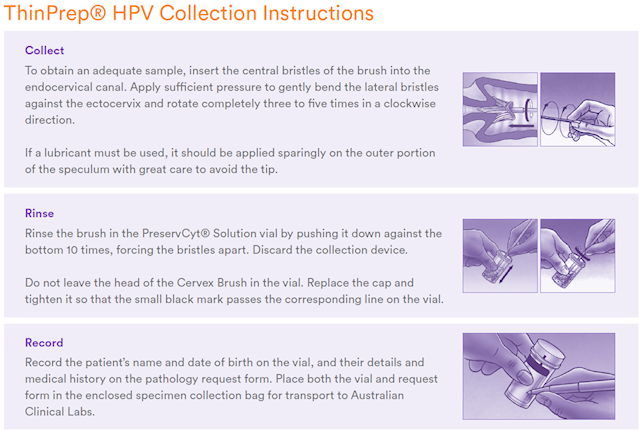
Further testing - Screening for common STIs
Screening for common STIs at the same time as the Cervical Screening Test is the ideal opportunity, as the same specimen can be used.
Statistics show the rates of Sexually Transmitted Infections (STIs) throughout Australia are rising. Research suggests that 75% of women with chlamydia infection1, and up to 80% of women with gonorrhoea infection2 are asymptomatic.
Although these infections may be asymptomatic, they have great potential for long-term harm, being highly associated with pelvic inflammatory disease, infertility and pregnancy complications such as ectopic pregnancy.
The first Cervical Screening Test at 25 years of age is an ideal opportunity to screen for these common STIs, as chlamydia and gonorrhoea testing can be performed on the same ThinPrep vial used to collect the Cervical Screening sample. No extra specimen collection is required.
Testing for chlamydia and gonorrhoea in Australia is performed using molecular PCR techniques, and is fully Medicare rebatable, both symptomatic referrals and for screening.
References - Accessed 22/09/2018
1. https://www.healthdirect.gov.au/chlamydia
2. http://www.sti.guidelines.org.au/sexually-transmissible-infections/gonorrhoea#clinical-presentation
Watch our webinars
We have posted a webinar from our expert pathologist, Dr Catherine Uzzell, to explain the changes to the HPV program. The Webinar is pre-recorded and lasts for just over 7 minutes and will address all your questions to prepare you for when the changes come into effect.
To view the other parts of the HPV update webinars, click here.
Also available for viewing is a webinar on Molecular Screening for Sexually Transmitted Infections, presented by Dr Catherine Uzzell, which is 8 minutes in length.
Guide to self-collect HPV testing
As of 1 July 2022, self-collect HPV testing is now available to anyone undergoing cervical or vaginal HPV screening aged 25-74 years;
- Must be over 24 years and 9 months
- Must be due for screening (first test or > 4 years and 9 months since a negative screening result)
- Must not require co-test
- Must be collected under the supervision of a healthcare professional
Participants may also be offered self collect sampling for follow up of Intermediate Risk HPV results at the 12 month rescreen interval.
Self collection is not recommended for;
- Symptomatic patients
- Patients undergoing Test of Cure surveillance
- Previous total hysterectomy for high grade squamous or glandular lesions
- Diethylstilbestrol (DES) exposure in utero
- Patients who have had adenocarcinoma in situ (AIS)
Self collected samples must be clearly identified as a self-collect sample, as they are not suitable for reflex LBC testing.
- Where a self-collect specimen is positive for High Risk HPV, the patient will be immediately recommended for colposcopy.
- Where a self-collect specimen if positive for Intermediate Risk HPV, the patient will require a clinician-collected sample taken from the cervix during a speculum examination, for cytological (LBC) examination.
- If a self-collect specimen is negative for Intermediate and High Risk HPV, the patient will be recommended to rescreen at the usual 5-year interval.
What’s needed for self-collect testing at Medical Practice:
NB: Only Copan FLOQSwab 552C.80 is validated for use
1. Clinical Labs request form - ensure self-collect HPV test (at Medical Practice) is noted
2. Clinical Labs HPV testing self-collect instructional flyer for patients (see below)
3. Copan FLOQSwab® for vaginal self-collection (552C.80) (Red Top) – available from Clinical Labs
4. ThinPrep® vial – available from Clinical Labs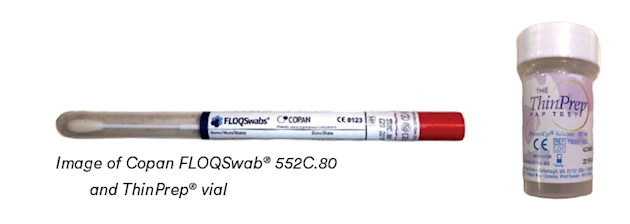
What’s needed for self-collect testing at home:
NB: Only Copan FLOQSwab 552C is validated for use
1. Clinical Labs request form - ensure self-collect HPV test (at home) is noted
2. Clinical Labs HPV testing self-collect instructional flyer for patients (see below)
3. Copan FLOQSwab® for vaginal self-collection (552C) (Red Top dry swab) – available from Clinical Labs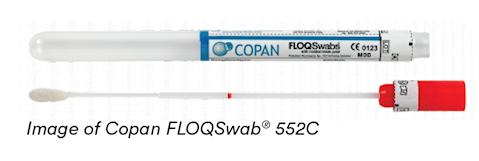
For detailed step-by-step instructions for HPV self-collect testing at Medical Practice and HPV self-collect testing at home, please download the Doctor Self-Collect Guide below.
Download Doctor Self-Collect GuideDownload Patient Self-Collect Instructional Flyer
A summary of the Cervical Screening Program
- 5-yearly cervical screening
- Primary HPV molecular test with partial HPV genotyping
- Reflex LBC (liquid based cytology) triage (NOT CO-TESTING)
- HPV vaccinated and unvaccinated patients 25 to 69 years with an exit HPV test between 69 & 74 years
- Invitation and reminders will be sent to screening participants
- Provision made for self-collection of a HPV sample for all screening participants aged 25 to 74 years



